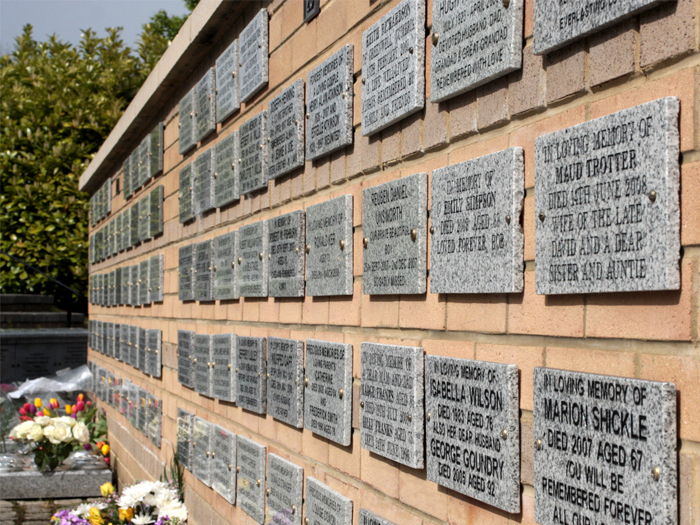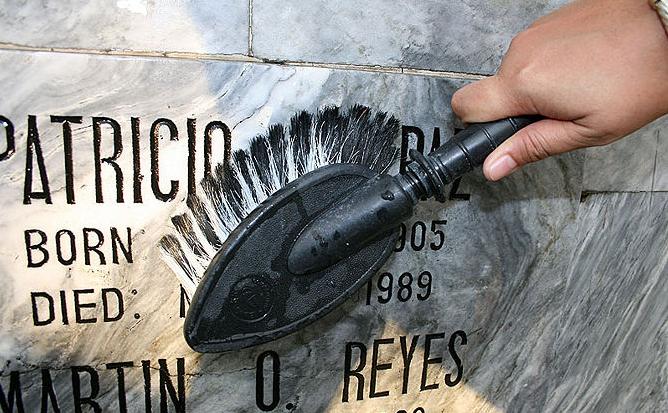Memorial plaques are often used to commemorate loved ones, listed buildings and monumental events and choosing a suitable design when emotions are running high can be stressful . This website has been produced to help you decide what plaque will be the most suitable for your needs and to guide you through the various options available. I have recently added a number of additional pages in response to specific questions I have received. If anything requires further explanation, or you would like to know more about me, please see this page.
Memorial plaques are highly functional. They can be mounted onto gravestones; fused with buildings; hanged from walls; attached to benches; or even used as a trophy. In the UK, English Heritage use plaques to commemorate buildings that are deemed culturally significant. These ‘Blue Plaque Schemes’ are even used by local councils and charitable organizations throughout the country.
Memorial plaques represent greatness and can be a very respectful and dignified way of honouring a loved one. This website covers everything there is to know about plaque designs, materials, engravings, and regulations.
Types of Memorial Plaque
Not all memorial plaques are made from bronze and affixed to stone. While they’re certainly the most common, there are an abundance of different styles to choose from. It’s important to select your text prior to choosing your style, otherwise you could run into space issues and may have to forfeit part of your message.
Memorial plaques are traditionally made out of metal, wood, stone or ceramic. However, the material can vary depending on the engraving style, image and attachment area.
Solid Cast Plaques
Most solid cast plaques are made from either bronze or aluminium. Bronze is more suitable if the plaque is to be mounted outdoors as it requires little maintenance and isn’t as susceptible to water damage. Most solid cast plaques will also come with a two part polyurethane coating to further aid protection against weathering. It’s also worth noting that bronze plaques will get darker over time due to oxidization.

A cast bronze memorial plaque commemorating Word War 1 veterans.
Image Credit:Aura Bronze Plaques
Wooden Plaques
Wooden plaques are often more appropriate than metal or stone plaques, especially for interiors. Inscriptions are usually burnt into the wood using an engraving laser; however, many engravers still use the more traditional method of printmaking. Carving is achieved by printing an image on the wood, and then carving it out by hand with a chisel. The white cuts are then filled in using black ink.
Stone Plaques
There are three commonly used materials for creating stone plaques; granite, marble and limestone. Granite is the most widely available and generally the cheapest. It is also the most durable and always accepted in church yards. Marble has a shiny appearance and isn’t quite as durable as granite. Limestone (Portland stone) almost exclusively comes in a light beige colour and is the least popular of the three.

A collection of granite memorial plaques.
Image Credit:Durhum Crematorium
Ceramic Plaques
Ceramic memorial plaques are often used for more intricate designs that have a lot of colour, such as photos. Ceramic plaques are usually mounted to granite and fixed to gravestones. They can also be used as gifts for loved ones and are commonly given to babies as christening presents by the elderly. Ceramic plaques are very fragile and require regular maintenance if attached to gravestones in order to prevent water damage.
Plaque Inscriptions
The inscription is without a doubt the most important element of a plaque’s design as it’s the message that will keep the memory its representing alive. Inscriptions are etched directly into plaques and can’t be amended afterwards; therefore, great care should be taken when choosing the contents of the message.
Epitaph
Epitaphs are etched directly into memorial plaques for gravestones. They are messages that summarize the deceased’s life and personality. Epitaphs commonly consist of bible passages and poetry.
Loving Messages
Sometimes the elderly will inscribe personal messages onto ceramic plaques for new-borns so they’ll have an ever lasting memento from them. These loving messages usually consist of something short and concise such as, “To my darling…” and “From your loving…”
Name and Date
The name, date of birth and date of death is inscribed on almost every memorial plaque, either as a standalone message or in addition to an epitaph. This is the only element of most memorial plaques that is inscribed using capital letters. Other lettering is usually lower case and in italics.
Rules and Regulations
Cemeteries and church yards may have specific rules and regulations regarding the use of memorial plaques on headstones. Shiny surfaces may not be permitted as they can spoil the aesthetic of the traditional stonework. In addition only religious inscriptions may be allowed. Cemeteries are generally more relaxed and will permit anything – regardless of faith – providing it isn’t obscene or offensive.
Before you purchase a memorial plaque always check with your local parish. They may bend the rules if the deceased was a regular church goer; however, they’ll almost certainly reserve the right to remove the plaque in the future if they choose. For this reason taking a traditional approach is generally recommended for church yard burials.
Production Times
After ordering a memorial plaque most suppliers will have a 3-4 week production period; however, it’s not uncommon for it to take even longer. If it’s required for a specific date most companies will charge extra for guaranteed production and delivery.
Gravestone Installation
Gravestones can only be installed six months after the burial in order to give the ground time to settle. Memorial plaques, however, can be put in their place if they’re attached to a slant marker or unfixed memorial. In the event of a cremation you don’t need to wait for the ground the settle and the installation can take place immediately. While you may be permitted to amend the plaque in special circumstances, cemeteries and church yards will install gravestones using their own on-site staff.
Paying for Memorial Plaques
If you’re thinking about purchasing funeral insurance or taking out a plan with a funeral director, you may be able to cover the costs of a memorial plaque yourself. Most companies will happily tailor their packages to suit your own personal needs.
Unlike gravestones, you can’t claim the costs for a memorial plaque out of the deceased’s estate prior to the deliverance of funds. The only way to cover the costs using the estate is for the next of kin to dedicate a portion of the money independently. Even if the deceased specifically states that they’d like some of the money to go towards a memorial in their will, the inheritor is under no legal obligation to abide by the request.
Cleaning and Maintenance
Regardless of the material, memorial plaques will inevitably discolour and degrade. While there is no sure-fire solution to this problem, regular maintenance and re-application of varnishes and paints, etc. will certainly help. Before you start cleaning or restoring any plaque, always remove it from its base and ensure the process is conducted in a clean and dry place.
Cleaning Solid Cast Plaques
Solid cast plaques require cleaning every five years. Annual cleaning can be detrimental and cause more damage than good. To clean bronze or brass:
· Brush off any dust using a flannel cloth before you begin; this will prevent scratching.
· Softly cleanse the surface with a non-ionic detergent and sponge.
· Rinse off the detergent with distilled water and dry it immediately with a flannel cloth.
· Apply brass or bronze wax using a different sponge, and then buff it with a fresh flannel cloth to bring out the shine.
· If the plaque was covered in a polyurethane coating, add a fresh layer using a natural bristled paintbrush.
· Make sure the plaque is completely dry before re-attaching it to the base.
Cleaning Stone Plaques
Not all stone plaques are robust and durable. While you can clean granite with a pressure washer, limestone, sandstone and slate requires a gentler touch. Before you start the cleaning process make sure the plaque is free from flaking otherwise you could damage it even more. To clean stone:
· Create a cleaning solution using non-ionic soap and distilled water.
· Dip a natural bristled brush in the solution and scrub the surface of the stone. Do not use a metallic brush or scouring pad if you’re cleaning polished stone or slate. This can cause surface scratches and make the plaque look even more worse for wear.
· Once you’ve finished applying the cleaning solution leave it for 20-30 minutes to take action, and then rinse the surface with distilled water.
· If you’re cleaning an indoor plaque dry the surface before putting it back on display.

Cleaning a polished granite memorial plaque.
Image Credit: Wiki How
Cleaning Wooden Plaques
Wooden plaques are a little more difficult to clean as you could easily splinter the surface or cause water damage. Wood plaques will most likely have a shorter lifespan than metal and stone plaques, especially if they’re placed outdoors. To clean:
· Wipe down the plaque with a duster and buff the surface with wood polish.
· After you’ve thoroughly cleaned the surface and removed any grime, apply a suitable wood varnish.
Engraving Photos and Images
Photos and images can be incorporated into any plaque design, regardless of the material. Engravings can, however, significantly increase the overall price.
Laser Engraving
Laser engraving is the most common technique and is often used by stone masons when inscribing granite, limestone and sandstone. Laser engraving can’t produce colour images; however, it can create highly detailed pictures on virtually any material.
Hand Carving
Hand carving is the most expensive technique due to the amount of labour involved. That said, it can be highly personalized and will leave the plaque with a finish that can’t be replicated. Sometimes it’s the imperfections and rustic look that makes hand carving appealing.

Hand carving a slate plaque
Image Credit:Ieuan Rees
Hand Stamping
Hand stamping is an age-old method that’s been used for hundreds of years. The process involves creating an engraving on a block of metal and hammering it into the material. This method isn’t particularly functional and can be quite expensive; however, it can create a very distinct image.
Ceramic Attachments
Embedding ceramic photographs is the method of choice for people who want full colour images. Ceramic attachments are fairly cheap, but will often fade over time, even with regular maintenance. They can, however, be easily changed when the time comes.
Specialist Memorial Plaques
Specialist memorial plaques can sometimes be more suitable than a generic design. The plaque should represent the life of the deceased and summarize the way in which they lived their life. Specialist plaques can say a lot about someone, even at a glance.
Military Memorial Plaques
Military memorial plaques will generally contain the fallen soldier’s coat of arms or regimental insignia. In addition they will usually have written information regarding their line of service. Families of soldiers who were killed in active duty will have the costs of the memorial plaque paid for by the state.
Children’s Memorial Plaques
Memorial plaques that are specifically designed for children are usually a little more colourful and may contain an image of their favourite hobby, such as a guitar, football or ballet shoes. Fonts are also generally less traditional and more playful.
Plaques provide a dignified and timeless way of memorializing a loved one. Finding a suitable design that reflects the life and personality of the deceased isn’t easy, but hopefully you’ve found this guide both interesting and insightful. If you have any further questions please don’t hesitate to get in touch.